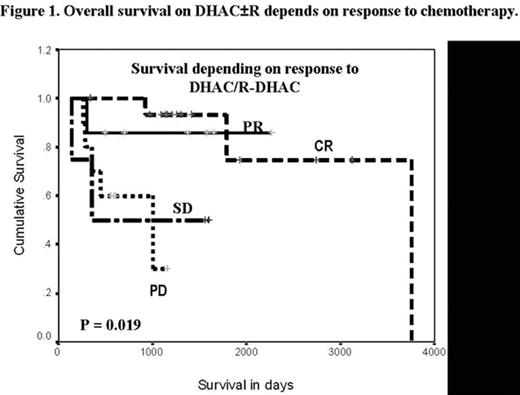Abstract
Introduction: Relapsed/refractory B-cell lymphomas are challenging to treat but can be salvaged by High- dose chemotherapy and stem cell transplant (HDC-SCT). Various non-cross resistant salvage regimens have been developed to treat patients with relapsed/refractory B-cell lymphoma. In this report we present our institution’s experience with DHAC ± R in patients requiring salvage therapy prior to HDC-SCT.
Methods: The DHAC regimen consists of Dexamethasone at 15mg/m2/dose po every 6 hrs x 10 doses, High-dose Ara-C at 3G/m2 (1.5G/m2 if >50 yrs old) iv over 3 hrs every 12 hrs for 4 doses and Carboplatin at 200mg/m2 iv every 24 hrs for 2 doses. When utilized, patients received rituximab at the standard dose of 375mg/m2, 48 hrs prior to each cycle of DHAC. Growth factor support and anti-microbial prophylaxis was implemented 24 hrs after completion of chemotherapy. The regimen was repeated every 21 days for 2-3 cycles prior to HDC-SCT. We treated 37patients with relapsed/refractory lymphomas; median age was 47 yrs (range 18 – 78); 25 male and 19 females. Histological subtypes included (DLBCL (n=16); follicular lymphoma (n=10); marginal zone lymphoma with blastoid features (n=1); small lymphocytic lymphoma (n=1) and Hodgkin’s lymphoma (n=8). The majority of the patients presented with Stage III (n=43%), Stage IV (n=39%) at the time of DHAC therapy. Seventeen patients were treated with R+DHAC, and 20 were treated with DHAC, either as second line or third line salvage therapy. 19 of 37 proceeded to HD-SCT.
Results: The overall response rate (ORR, CR+PR) for all patients was 61% (16 CR and 7 PR). The remaining 14 patients had either stable disease (n=10) or progressed (n=4). Complete responders (43%) had a longer median survival of 107 (range 78 – 136) months compared to 66 months (range 49 – 83) for partial responders (19 percent) and non-responders who had a mean survival of 30.8 months (range 9–54),[P = 0.008]. Patients who proceeded to HD-SCT had an ORR of 79% [11CR and 4 PR] compared to only 44% in those who did not [5 CR and 3 PR]. The median survival in patients transplanted was longer than non-transplanted patients (92 vs 68 months).
Conclusions: DHAC with or without rituximab appears to be an effective salvage treatment for patients with relapsed or refractory advanced-stage B-lymphoma undergoing HDC-SCT. An overall response of 61% which increases to 79% when followed by autologous SCT were demonstrated. Median survival was longer in patients experiencing CRs compared to partial or non-responders suggesting that the quality and quantity of the cytoreduction after salvage chemotherapy is an important predictor factor of post-SCT survival. Data looking at prognostic factors predicting response to DHAC±R treatment are being analyzed and will be reported at the ASH annual meeting.
Author notes
Disclosure: Consultancy: Celgene, Millenieum. Research Funding: Pharmion. Honoraria Information: Celgene, Millenium and Pharmion. Off Label Use: Carboplatin in lymphoma.


This feature is available to Subscribers Only
Sign In or Create an Account Close Modal